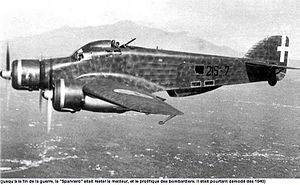| SM.79 Sparviero | |
|---|---|
 | |
| General information | |
| Type | Medium bomber, torpedo bomber |
| National origin | Italy |
| Manufacturer | Savoia-Marchetti |
| Status | Retired |
| Primary users | Regia Aeronautica |
| Number built | 1,240[1] |
| History | |
| Manufactured | 1936–1945 |
| Introduction date | 1936 |
| First flight | 28 September 1934 |
| Retired |
|
| Developed into | Savoia-Marchetti SM.84 |
The Savoia-Marchetti SM.79 Sparviero (Italian for sparrowhawk) was a three-engined Italian medium bomber developed and manufactured by aviation company Savoia-Marchetti. It may be the best-known Italian aeroplane of the Second World War.[2] The SM.79 was easily recognizable due to its fuselage's distinctive dorsal "hump", and was reportedly well liked by its crews, who nicknamed it il gobbo maledetto ("damned hunchback").[3]
The SM.79 was developed in the early 1930s. It was a cantilever low-wing monoplane of combined wood and metal construction, designed with the intention of producing a swift eight-passenger transport aircraft capable of besting the fastest of its contemporaries, but its potential as a combat aircraft quickly attracted the attention of the Italian government. Performing its first flight on 28 September 1934, early examples of the type established 26 separate world records between 1937 and 1939, qualifying it for some time as the fastest medium bomber in the world.[4] As such, the SM.79 quickly came to be regarded as an item of national prestige in Fascist Italy, attracting significant government support and often being deployed as an element of state propaganda. Early on, the aircraft was routinely entered in competitive fly-offs and air races, seeking to capitalise on its advantages, and often emerged victorious in such contests.
The SM.79 first saw combat during the Spanish Civil War. In this theatre it normally operated without fighter escort, relying on its relatively high speed to evade interception. While some problems were identified, and in some cases resolved, the SM.79's performance during the Spanish deployment was encouraging and stimulated demand for the type, including a decision to adopt it as the backbone of Italy's bomber units. Both Yugoslavia and Romania opted to procure the type for their own air services, while large numbers were also procured for the Regia Aeronautica. Almost 600 SM.79-I and –II aircraft were in service when Italy entered the Second World War in May 1940; thereafter, they were deployed in every theatre of war in which the Italians fought.
The SM.79 was operated in various capacities during the Second World War, initially being used mainly as a transport aircraft and medium bomber.[2] Following pioneering work by the "Special Aerotorpedoes Unit", Italy put the type to work as a torpedo bomber; in this role, the SM.79 achieved notable successes against Allied shipping in the Mediterranean theatre of the war.[5] A specialised drone version of the aircraft flown by remote control was also developed, although the Armistice with Italy was enacted prior to any operational deployment. It was the most numerous Italian bomber of the Second World War, with about 1,300 built. The type would remain in Italian service until 1952.[6]
- ^ "Savoia-Marchetti SM.79."alieuomini.it Archived 23 August 2010 at the Wayback Machine
- ^ a b Angelucci and Matricardi 1978, p. 198.
- ^ "Savoia-Marchetti SM.79." Aviation History On-Line Museum. Retrieved: 26 December 2011.
- ^ Arena et al. 1994, p. 7.
- ^ Arena et al. 1994, p. 9.
- ^ Mondey 1996, p. 236.